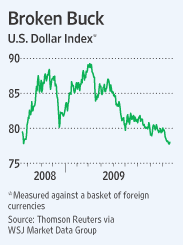High-tech industry executives and entrepreneurs are surging into
2010 House, Senate and governors’ races, sensing that a
punishing recession has created an electorate hungry for outsider candidates with management and job creation expertise.
Some of these would-be politicians are leaving companies at the pinnacle of their careers, some are the bored rich who are ready for the next big challenge, and some have dabbled in public service but are now looking to dive in full time.
California gubernatorial candidates
Meg Whitman and Steve Poizner
are two of the several candidates
running in 2010 with tech-industry
credentials. Photo: AP photo
composite by POLITICO
In almost every case, their ability to pour large sums of
their own money into the contest makes them competitive enough to warrant notice.
“Who better to start with than a group of hyper-ambitious men and women with millions of dollars burning a hole in their pocket, all looking for the next big thing to do in their life?” said Bill Whalen, an expert on state and national politics at Stanford University’s Hoover Institution. “These are all people who have achieved and overachieved.”
Jack McDonald, a Democratic House candidate in Texas who until recently ran a 1,200-employee information technology consulting firm, said it was local business leaders who urged him to run.
“I’ve had a good run in business,” said
McDonald, who is challenging incumbent Rep. Michael McCaul (R-Texas). “What I’ve heard from people is that we need to get folks with real world experience involved. The problems that we face are too big to leave to career politicians of either party.”
McDonald is joined by likeminded hopefuls in at least a dozen states across the country.
These high-tech execs-turned-candidates told POLITICO they believed the economic slump that has endangered the political fortunes of many incumbents might actually boost their own.
“I think it’s no coincidence that business people are beginning to step up and want to apply their skills to politics,” said Steve Poizner, a
Republican candidate for governor of California and a former Silicon Valley entrepreneur.
Poizner, the state’s elected insurance commissioner who spent two decades running technology companies before entering politics, said that although the transition from the private sector to public life can be jarring, it’s one that more and more tech executives are willing to make.
“It all fits together really,” Poizner said. “People who are good at innovation, people who are entrepreneurial would naturally believe they have the skills and the vision to try to get their states back on track.”
Poizner said he was driven to run for office by the fact that “California is a fantastic state that was heading off a cliff.” Now he’s asking voters to elect him, in part on his track record in the business world.
The same can be said of Poizner’s main rival in the GOP gubernatorial primary,
Meg Whitman, the billionaire former eBay CEO. She is perhaps the most prominent high-tech executive to launch a political career this year, along with the ex-CEO of Hewlett Packard, Carly Fiorina, who is a potential challenger to Sen. Barbara Boxer (D-Calif.).
Whitman has already poured $19 million of her own money into the race, and earlier this month she pledged to contribute $250,000 to the state GOP for voter registration efforts. Fiorina, who has not officially announced her candidacy, also has a significant personal fortune at her disposal—a critical asset in a large and expensive state like California.
In neighboring Oregon, Allen Alley, the former CEO of a global semi-conductor company and venture capitalist, is vying for the Republican nomination for governor. Alley said that he finds running a startup company and running a political campaign to be “amazingly similar” endeavors.
“You start out with an idea, you have no brand awareness, no name recognition,” he said. “You get people to believe in your idea and hopefully you can convince them that you’ve got the right product at the right time.”
Dick Green, a Republican candidate in an open Chicago-area House seat, said he has not found the transition quite that seamless. Green, who founded the financial information website
Briefing.com, likened the move from business to politics to “jumping into a cold swimming pool.”
“It’s a whole different ball game,” Green said. “When you run a business, you’re in charge. I’m trying to run for a position where the voters are in charge of me.”
Green has entrusted the day-to-day management of his Internet business to his wife while he campaigns full time for Congress. He said that after talking it over with his family, he decided that it was the right time to run as an outsider candidate. Though Green said he was aggressively fundraising, he acknowledged that he planned to dip into his own bank account too.
This year’s crop of candidates are trying to follow in the footsteps of others who have used their success in high-tech fields to launch political careers—pols like Sen. Mark Warner (D-Va.), who made his money running cellular phone companies, and Rep. Jared Polis (D-Colo.), who founded several Internet startups before going into politics.
Mike Dennehy, a New Hampshire-based political consultant who in 2002 ran the successful gubernatorial campaign of Republican Craig Benson, who founded a the now-defunct Cabletron Systems, a company that designed and manufactured computer networking equipment, said that high-tech industry executives aren’t always a natural fit for politics.
“CEOs are used to getting their way in the business world. They typically have a profile that’s hard-nosed, that in many cases is ‘my way or the highway,’” Dennehy said. “They often don’t have a collaborative, consensus-building profile that politicians run on. So they enter the process with a different mindset.”
He also cautioned that these candidates—like any others from the private sector—bring their own vulnerabilities, including previous campaign contributions to members of other parties, which can raise questions about their party loyalty. Then there is the perception that they are using their personal wealth to “buy” political office, and their own business records, which are not always spotless.
In California, recently, Meg Whitman got a taste of the difficulties outsider candidates can face when newspaper reports revealed that she had a
long history of failing to vote in state and national elections. In 2008, when Alley ran for Oregon state treasurer, Democrats put up a website criticizing what they said were his business failures.
“Allen Alley: experience you can’t trust,” the site read.
The risks have not deterred former Gateway Computers executive Rick Snyder, a Republican candidate for governor of Michigan, who said that going into politics was always part of his life plan. He said he was comfortable enough financially to give politics a try and also provide his campaign with $340,000 of seed money.
Snyder said he wanted to run not only because of his experience at technology and venture capital firms but also because, “I’ve got one of those personality profiles -- a lot of times when people say, you cant do something, I just have to go for it.”
Jack McDonald in Texas makes a similar argument. He contends that 2010 is the right time to “get some folks in government who know how to create jobs, who know how to balance a budget, who understand a global economy and the investments we need to make.”
McDonald, who remains chairman of the board of the Austin-based company that he helped take public in 2001, said that the career change has been invigorating.
“I love startups,” McDonald said, echoing Oregon’s Alley. “In a sense, a political campaign is like a startup. There’s that adrenaline, that energy, you get young people involved, you create a sense of mission and purpose and enthusiasm. It’s exhilarating.”
- Via
Politico

























![[Most Recent USD from www.kitco.com]](http://www.weblinks247.com/indexes/idx24_usd_en_2.gif)










